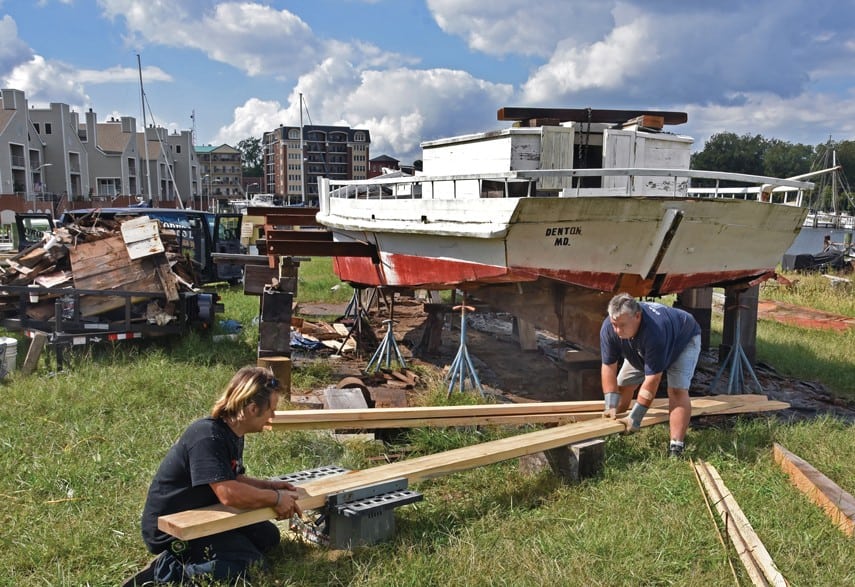
It all began because of a misunderstanding I had in the middle of the night with a fellow insomniac. Half asleep and fully supportive, Rita said she once lived with a kayak being built in her living room. Although, that hadn’t been what I meant by staying afloat, I pressed her for more information. She told me about a company that will send a long flat box of pieces and instructions to your front door.
Coincidentally, I was driving past this very company (Chesapeake Light Craft) every Monday night on my way to and from a class for regional volunteers at the Chesapeake Bay Foundation. The kits were also on sale, and so it seemed only apt to choose the boat design named for
our region for my first build, the Chesapeake 17. I made arrangements to pick the box up to save on the shipping cost and then waited a month for the kit to be assembled. I was heading to Costa Rica for a month in an effort to avoid the Christmas holiday season. The boat would ensure my return.

From day one, when I showed up unprepared in my Honda Accord, I realized I had to start thinking more strategically about the reality of this undertaking and the possibility that I was in way over my head. I returned rather sheepishly in a borrowed farm truck, hoisted the eight-foot-long box in the back, and strapped it down before driving back over the Bay Bridge to a garage by the frozen Chester River.
The next challenge, aside from the waves of anxiety about this undertaking, became heating said garage to at least 60 degrees in the middle of winter. That didn’t become even remotely possible until February, and so, while I waited, I read the instruction manual, and took a shop-safety class, because I hadn’t used anything more dangerous than hand tools since a brief high school shop class.
The manual mentioned cutting PVC pipe to make C clamps, and this seemed like something I could do while waiting for warmer weather.
My uncle set me to work in his shop, where I managed to create piles of plastic snow, jam a radial-arm saw full of shattered PVC pipe (despite that safety class), and eventually managed to assemble a nice pile of usable
C clamps.

When the outdoor temps finally cooperated, I mixed up some epoxy and got to work creating 16-foot-long sheer clamps, which are wooden strips running the length of the boat to provide a landing edge for the deck, and the side and bottom panels from the bits I yanked out of that eight-foot box. I sprinted toward becoming a pro at waiting for epoxy to cure. Which is to say, I had to learn patience, and just like the manual promised, the shape of a flimsy boat did happen rather quickly.
Before each step, I read the manual and watched the accompanying YouTube videos over and over while re-reading the directions. This went on for months of hours.
Novice mishaps of course happened, and included an epoxy end-pour dam breach, bubbles appearing in my once-perfect fiberglass, and a ridiculously misplaced deck beam. According to the boatbuilding forum, I wasn’t the only one making mistakes along the way, and that made me feel slightly better about my level of craftswomanship. The project took me four months of consistent, dedicated hours of work each week, and overall, I’m pleased with the results. The same uncle that witnessed the PVC cutting mishap admitted that he wasn’t sure I would end up with a waterproof product. Her name is Estrella, and she’s both gorgeous and water-tight.
Now I’m able to lug this slightly-heavier-than-it-should-be boat down to the dock, and paddle in and out of a creek along the Chester River. I follow the tides and observe the birds migrating in and out of the region. It turns out our osprey also head to Costa Rica to avoid Christmas. Estrella allows me to be more a part of the natural world than a plastic kayak ever did. Although the difference in maneuverability has taken some getting used to.
My goal now is to install a spray-skirt that will allow me to kayak all the way across the Bay, under the Bay Bridge and over to the Chesapeake Bay Foundation, where I teach yoga to the employees in thanks of the vital work they do. Someday, I hope to paddle all the way down to Virginia Beach.
Now that I’ve taken a navigation course at the Chesapeake Bay Maritime Museum in St. Michaels, I look forward to fully utilizing the Maryland Department of Natural Resources water trail guides and the National Park Service’s maps of Captain John Smith’s 1612 exploration of Bay. You don’t have to build your own boat to do the same (but could!) as there are several boat rental and tour companies operating in the region. Either way, I’ll see you out on the Bay!
—Amy Genevieve Kozak



